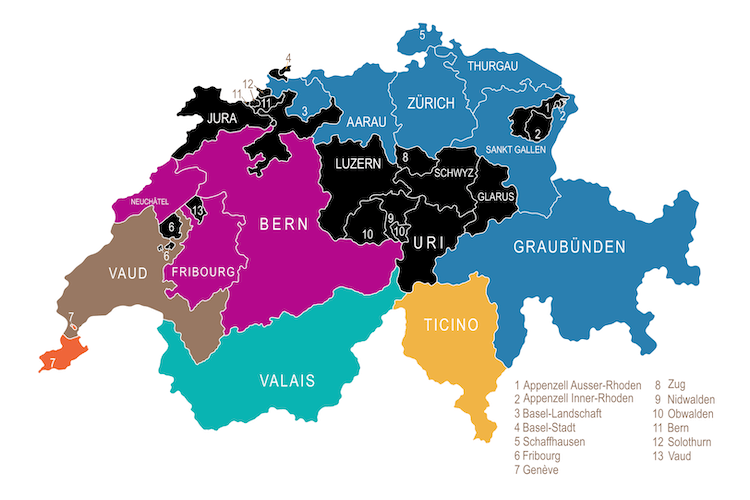Swiss wines are often overlooked by the general public, yet they deserve the full attention of connoisseurs.
Switzerland has a unique winegrowing heritage, influenced by its Alpine landscapes and rare grape varieties. Between ancestral traditions and modernity, Alpine vineyards offer exceptional vintages that rival the best European productions.
Let's take a look at what makes these wines so special, the emblematic grape varieties and the must-try Swiss wine regions.
A unique terroir shaped by the mountains
Alpine vineyards enjoy ideal conditions for producing wines of great finesse. Altitude, varied soils and the influence of lakes all contribute to a highly distinctive viticulture.
- A favorable climate: Thanks to the Alps and lakes, the climate is temperate, with warm summers and harsh winters. These temperature variations allow the grapes to develop good acidity and aromatic complexity.
- Diverse soils: The soil of Swiss wines varies from limestone to granite to schist, providing rich and varied taste profiles.
- Terraced vineyards: In some regions, such as Lavaux, vines are grown on steep terraces, offering ideal exposure to the sun.
This exceptional terroir produces wines that are balanced, elegant and full of character.
Rare and indigenous Swiss grape varieties
One of the most distinctive features of Swiss wines is the use of rare grape varieties not found elsewhere. Switzerland protects and enhances its winegrowing heritage with specific grape varieties.
Emblematic white grape varieties
- Chasselas: The most widely grown white grape variety in Switzerland, especially in the canton of Vaud. It produces light, floral, easily digestible wines.
- Petite Arvine: Native to the Valais, it produces elegant white wines with citrus and slightly saline notes.
- Amigne: A unique Valais grape variety, often vinified in a sweet version, offering aromas of honey and spices.
Typical red grape varieties
- Gamay: Less well-known than its Beaujolais cousin, Swiss Gamay is fruity and fresh, ideal for accompanying local cuisine.
- Humagne Rouge: An intense red wine with notes of black fruits and spices, often considered one of Switzerland's finest reds.
- Cornalin: A powerful, spicy, full-bodied red wine.
These grape varieties are the soul of Swiss wines, offering unique flavors that deserve to be explored.
Switzerland's major wine-growing regions

Switzerland has six major wine-growing regions, each with its own specific characteristics and dominant grape varieties.
1. Valais: the world's largest wine-growing region
With 5,000 hectares of vines, the Valais is Switzerland's leading wine-producing region. It is home to rare grape varieties such as Petite Arvine, Amigne and Cornalin. Its sunny, dry climate produces powerful, aromatic wines.
2. Vaud: the kingdom of Chasselas
The canton of Vaud is famous for its magnificent terraced vineyards overlooking Lake Geneva. Chasselas reigns supreme here, producing white wines of great finesse. Lavaux, a UNESCO World Heritage site, is one of the region's winegrowing jewels.
3. Geneva: modern, accessible wines
The Geneva region produces a variety of wines, from fruity Gamay to elegant whites based on Chardonnay and Sauvignon Blanc. It's a dynamic region, constantly innovating.
4. Ticino: home of the Merlot grape
Ticino, with its more Mediterranean climate, is renowned for its elegant Merlots. This red grape expresses luscious notes of black fruit and spices.
5. Neuchâtel: the birthplace of Œil-de-Perdrix
This region is famous for its Œil-de-Perdrix, a delicate rosé made from Pinot Noir grapes. Fresh, floral white wines are also produced here.
6. German-speaking Switzerland: discreet but qualitative
Although less well known, this region produces quality white and red wines, notably from Riesling-Sylvaner and Pinot Noir grapes.
Why do Swiss wines remain confidential?
Despite their exceptional quality, Swiss wines remain little known internationally. There are several reasons for this:
- Low production: Switzerland produces around 1 million hectolitres of wine a year, very little compared to its French and Italian neighbors.
- Strong local consumption: Over 90% of Swiss wines are consumed locally, leaving little room for exports.
- High production costs: Alpine vineyards require intensive manual labor, making costs higher than in other countries.
However, their quality and authenticity make them increasingly sought-after by wine lovers.
What dishes to serve with Swiss wines?
Swiss wines go perfectly with local and international cuisine.
- A Chasselas is ideal with raclette or fondue.
- A Cornalin goes very well with grilled red meat.
- A Swiss Pinot Noir sublimates poultry dishes.
- Petite Arvine goes perfectly with seafood or mature cheeses.
Switzerland's rare grape varieties offer a wide range of flavours for a variety of food and wine pairings.
Why try Swiss wines?
Swiss wines are a real discovery for connoisseurs in search of authenticity. Thanks to their rare grape varieties, varied terroirs and artisanal production, they offer a unique taste experience.
If you're a lover of quality wines and want to explore new flavors, let yourself be tempted by these exceptional vintages.
If you enjoyed this article, you may also be interested in "The world's most expensive wines: a glimpse into the world of luxury"!





